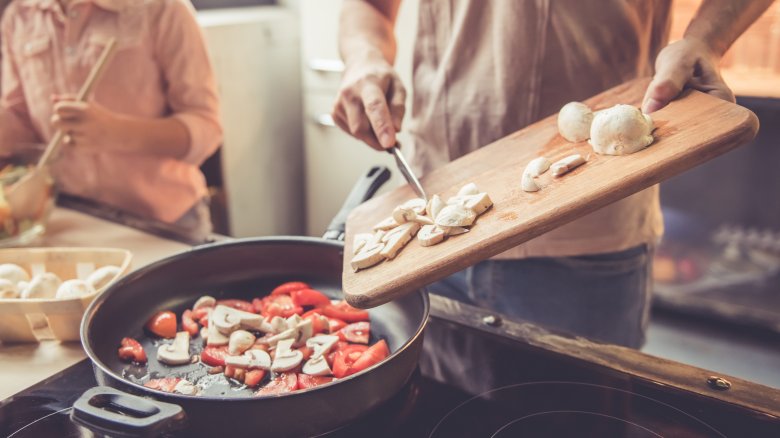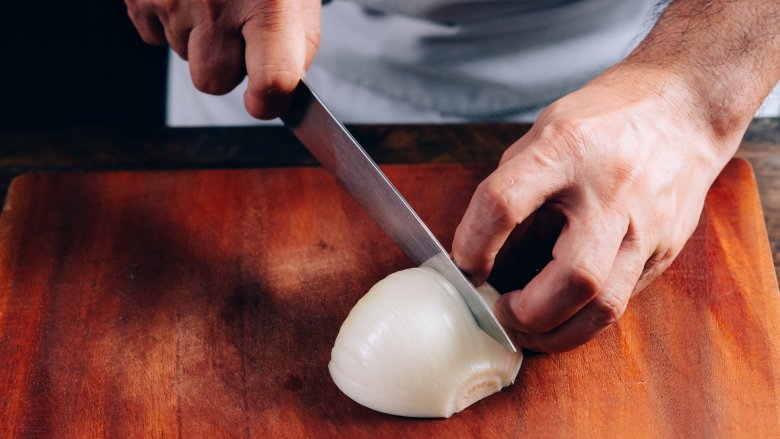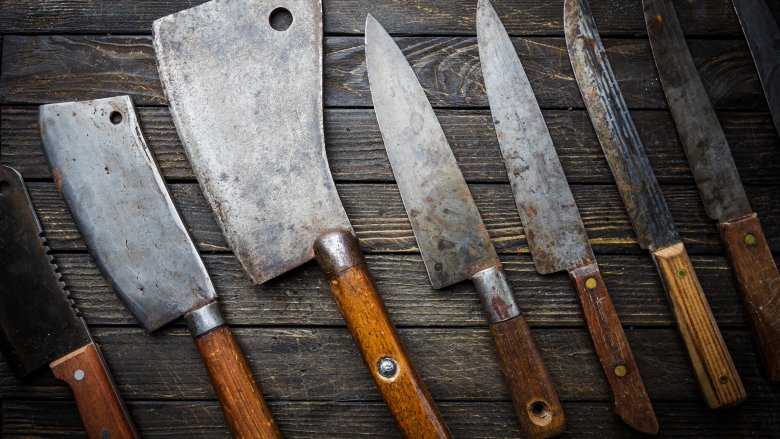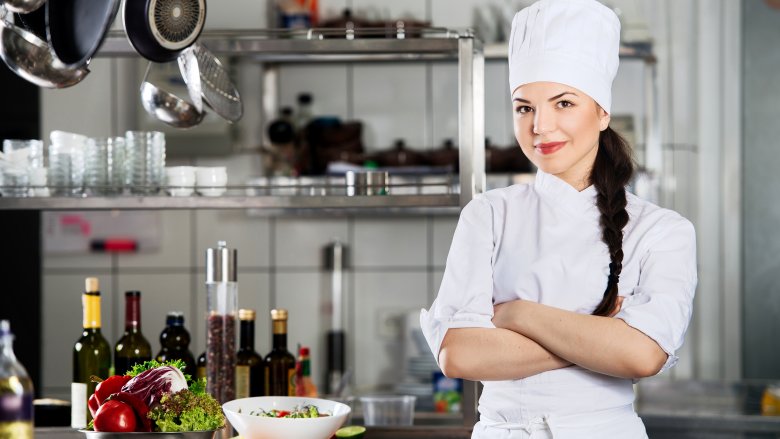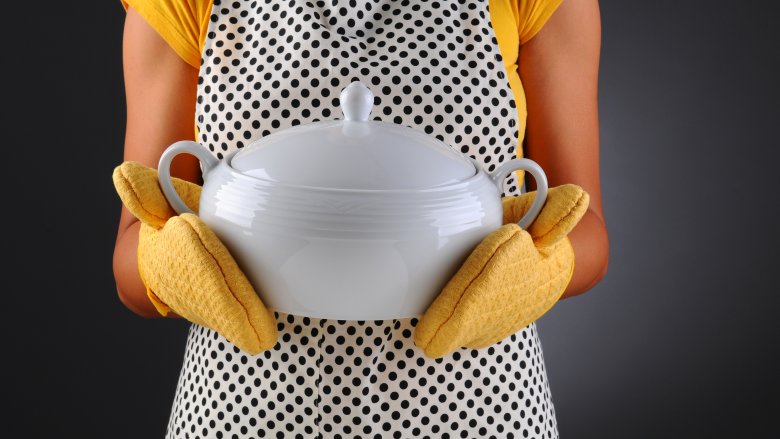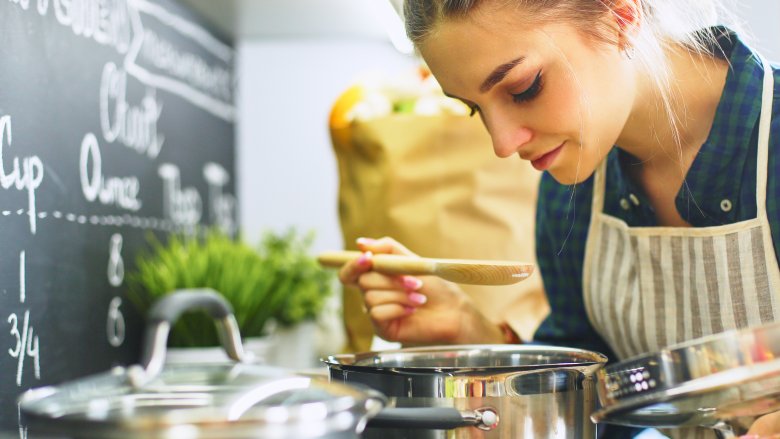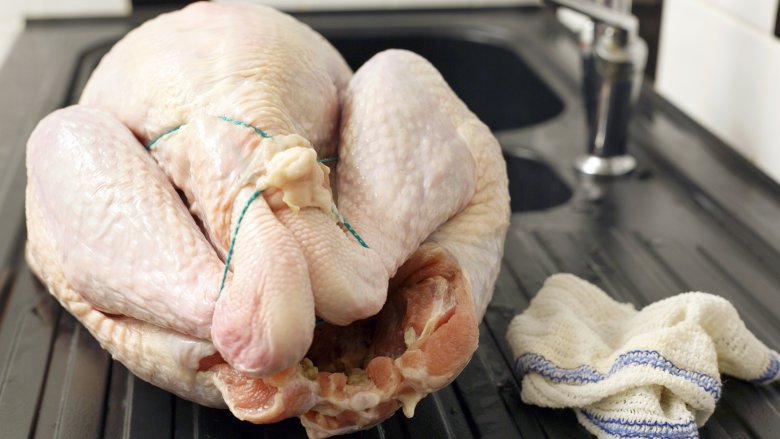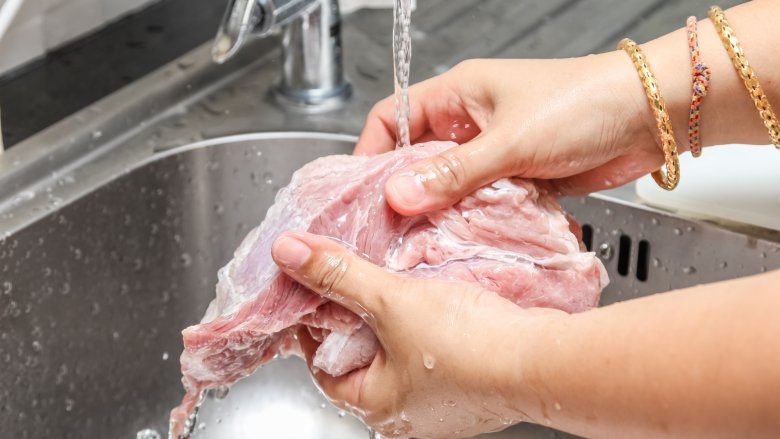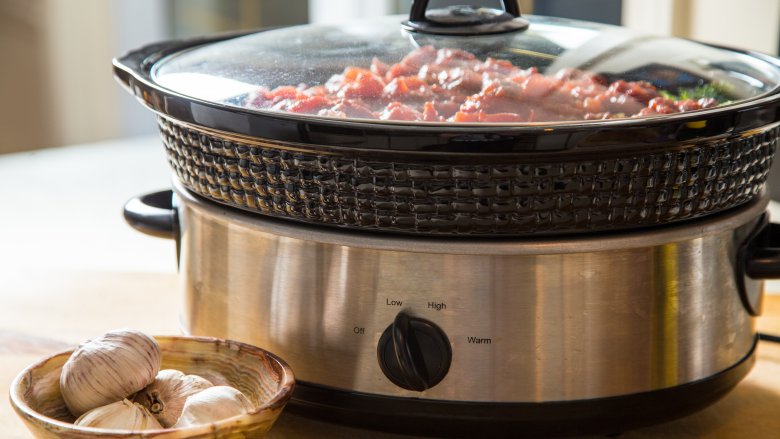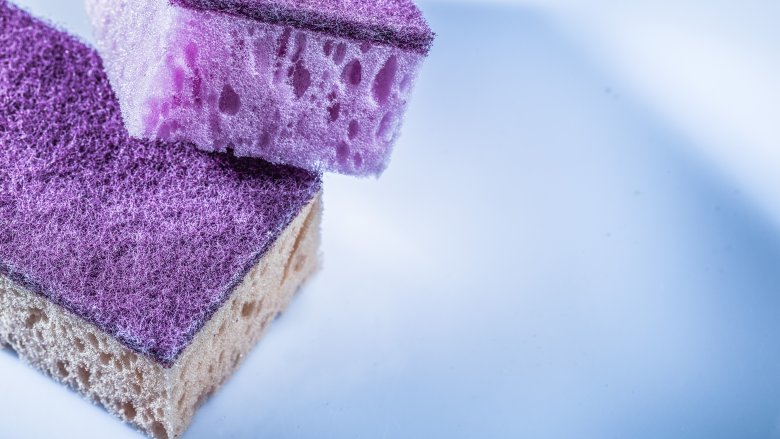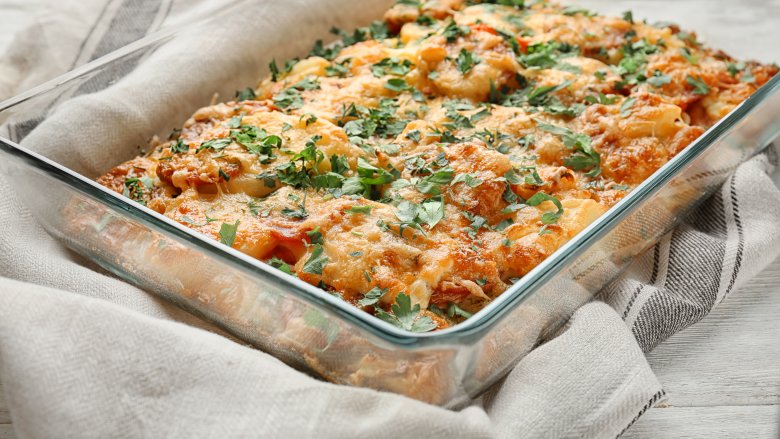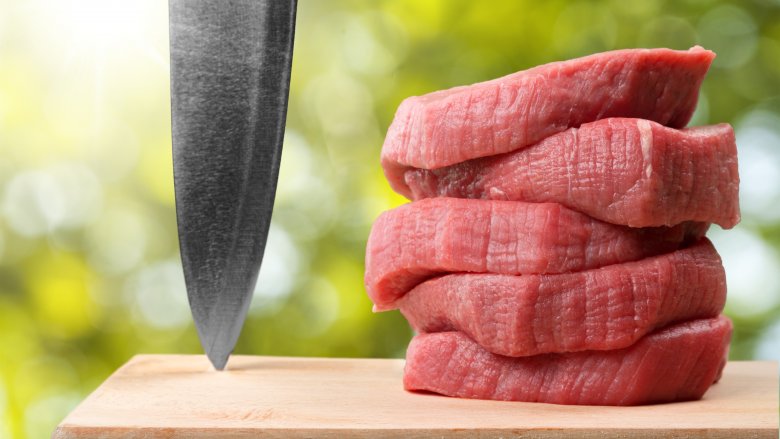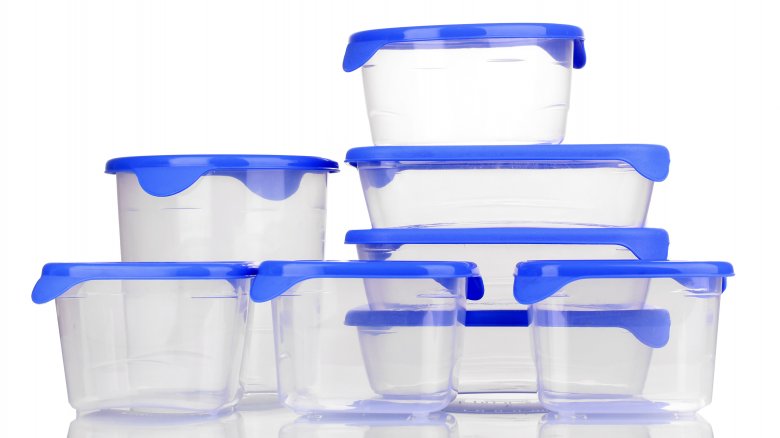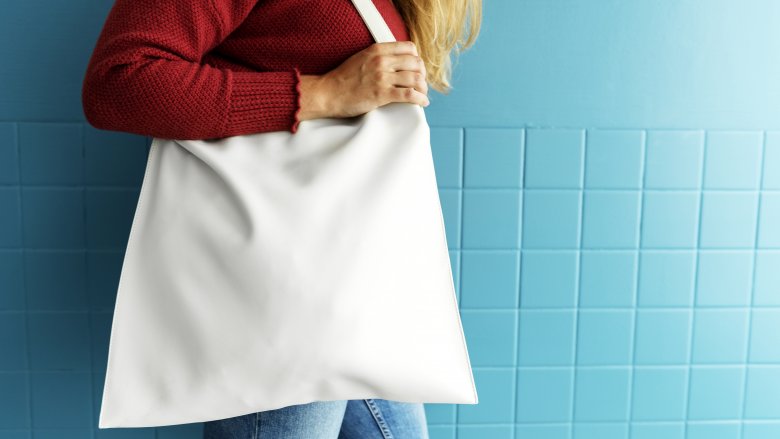Dangerous Cooking Mistakes You Didn't Know You Were Making
Cooking is complicated. Between the millions of recipes to choose from, the dozens of possible ways to prepare your food, and the hundreds of different tools to make it happen, it's no wonder cooking can be a daunting task for many people. Cooking can be many things for many people, but there's one thing cooking should never be: dangerous.
Between sharp objects, heat, and harmful bacteria, a lot can go wrong in the kitchen. And with all the information out there, it's not always easy to tell what's true and what's false. Here at Mashed, we want you to love food and cooking, but we also want you to be safe while you're doing it. So, we've gathered the most common dangerous mistakes every new cook makes — and some that even experienced chefs are probably guilty of. Here's a list of dangerous habits you should ban from your kitchen, and what you should be doing instead.
Not knowing basic knife skills
One of the most common mistakes made while cooking is not knowing the basics of proper and safe knife skills. Whether you're just starting out or working in a professional kitchen, nearly everyone has room for improvement. Besides, good knife skills aren't just for show — they also keep you safe.
When chopping anything that you have to stabilize with your non-dominant hand, that hand will be in danger of also getting chopped unless you know how to keep it safe. To avoid losing the tip of a finger, always curl your fingertips under your knuckles and use the tips of your knuckles to guide the knife.
As for the hand holding the knife, the middle, ring, and pinky fingers should be tucked under the handle. Your index finger should be curled around the part of the knife where the blade meets the handle. And finally, your thumb should be extended, resting lightly but firmly, parallel against the blade. This allows your hand to almost become an extension of the knife, giving you more control over your cuts.
Using dull knives
Everybody has knives in their kitchen, but not everyone has a knife sharpener — a fact that makes very little sense. While it might seem scary to the inexperienced cook so have such sharp knives around, it's actually much safer to have sharp knives than dull ones. When you use a dull knife, you have to use more pressure to get through whatever you're chopping. When you have to use more pressure, you have less control. And sadly, too often, more pressure plus less control equals a chopped finger.
A few things can make your knives dull, but the most common is knife abuse. According to the Society of American Silversmiths, abuse can be "putting the knife in a dishwasher... storing the knife loose in a drawer with other cutlery and utensils, laying the knife on a cluttered counter top... and dropping the knife into the kitchen sink when done using it." To avoid these main causes of dulling, always wash your knives with just soap and water and dry them afterwards. You should also store your knives in a suitable container, like a knife block.
Wearing the wrong clothes while you cook
Everyone knows that cooking can sometimes be stressful. But do you know what's really stressful? Accidentally catching on fire while cooking because you're wearing the wrong clothes. No one's saying you have to wear a full chef's uniform every time you cook — unless you want to — but there are a few guidelines you should follow to keep yourself safe.
While long sleeves can be helpful to protect your arms while cooking, always make sure they not too loose, as loose sleeves can easily catch on fire. Additionally, be aware of what shoes you're wearing in the kitchen. Ideally, you should be wearing something that covers the tops of your feet (knife drops happen!), is comfortable, and is slip resistant. The last thing you want is to slip while carrying a pot of boiling liquid and then spill it all over your exposed feet.
Finally, if you have long hair, pull it back. It may not be the most fashionable choice, but it's worth it. Hair is highly flammable — plus it's always awkward when someone finds a hair in a meal that you cooked. Oops!
Using a wet cloth as an oven mitt
There are a lot of ways to burn yourself in a kitchen –- on an open flame, on a hot pan, in an oven -– but one way you not might have thought of is from a wet oven mitt or cloth. Cloths or dish rags can be used as almost anything in the kitchen, from a mess cleaner, to a pot holder, to a pot coaster. The possibilities are endless! However, if not used correctly, a dish rag can lead to a pretty bad burn.
If you try to grab a hot surface with a wet towel or cloth, you will likely end up burning yourself. Because water can very easily transmit heat, and because the heat turns the dampness into steam, there's a pretty good chance your hand is going to get hot. And when that happens, you'll end up with a burn on your hand — and probably the food on the floor.
Leaving the kitchen while cooking
For some people, cooking is an artistic, relaxing addition to their day. For others, it's as much of a chore as doing laundry. For the latter group of people, it is often tempting to try to do something else while cooking to help pass the time. While multitasking can be perfectly safe, you should never leave the kitchen unattended if you're frying, grilling, boiling, or broiling food. These methods of cooking can often change quickly and require more immediate attention. If you are simmering, baking, or roasting food, you should also remain in the kitchen in case an emergency arises — but since those methods don't require as much attention, use a timer to remind yourself to check it periodically.
Additionally, no flammable objects, including cloths, wooden utensils, or food packaging should ever be left anywhere near the stove top. You should also keep a lid nearby to smother any small grease fires and have some kind of fire extinguisher within reach in case of an emergency. It doesn't matter how close you're watching if you're not ready to act!
Thawing meat on the counter
Perhaps one of the most commonly made mistakes in cooking is thawing or marinating food on the kitchen counter. It's certainly a tempting thing to do. When you're trying to thaw something, it makes sense to think that it will thaw faster if left on the counter, as opposed to in the refrigerator. While this might be true, it's also dangerous. Once any part of your food reaches room temperature, bacteria are able to multiply much faster.
The safest way to thaw meat, poultry, or seafood is by thawing it in the refrigerator. However, that can take a long time, depending on its size. One alternative way to speed up the process is by placing the meat in a sealed plastic bag and placing the bag in a bowl of cold water. Another way is by thawing it in the microwave. Just be sure to look in the manual for instructions for thawing your particular type of food. And finally, you can always cook your food without thawing. However, if you choose this method, be aware that your cooking time will be about fifty percent longer.
Washing meat or poultry
Nowadays, we like to wash everything to make sure it's clean. We wash out hands, our fruit, our veggies, but what about raw meat? Contrary to popular belief, washing your raw meat or poultry won't wash off or destroy most of the harmful bacteria that tend to live on raw meat. In fact, it actually just spreads the harmful bacteria around. If you wash the raw meat in your sink, chances are you'll just end up getting the bacteria on your dishes, utensils, sponges, and countertops.
Cooking your food to the minimum temperature is the only way to ensure the harmful bacteria is killed. Each type of meat has a different minimum temperature, so before you start cooking, make sure to look up what temperature your meat will have to get to. And finally, always make sure to let the meat rest after cooking for about three minutes before you start carving and serving. Not only does the USDA recommend this for safety reasons, but it also lets the meat soak up all those juices, making it moister.
Cooking frozen meats in a slow cooker
In our busy world, it's tempting to take short cuts, like defrosting and cooking your meats all at once in a slow cooker. While it's a tempting time-saver, it's not worth the risk. According to twohealthykitchens.com, "slow cookers don't reliably get frozen meat up to a safe temperature (above 140°F) evenly enough or quickly enough. Your meat will likely spend too much time hovering in the danger zone (from 40°F – 140°F), which opens the door for bacteria to flourish." While the website admits that people have tried it in the past and come out with dishes that didn't poison them, it seems silly to risk contaminating your food like that.
The USDA agrees, saying all meat or poultry should be thawed before cooked in a slow cooker.
Like we stated earlier, the safest way to thaw meat, poultry, or seafood is by thawing it in the refrigerator, or by placing the meat in a sealed plastic bag and placing the bag in a bowl of cold water.
Not replacing sponges or dish rags
We've all done it. We've all let that sponge live on the edge of the kitchen sink for a little too long. If you're waiting until the sponge starts to disintegrate to throw it away, you're waiting way too long. The qualities of a sponge that make it so good for absorbing liquids and cleaning dishes also make it a perfect home for germs and bacteria.
The only way to make sure your sponge isn't just spreading germs around is to replace it with a new one. Most experts recommend replacing your sponge every week to ensure bacteria doesn't have enough time to form. It's a small thing that most people don't think about, but it's a big step you can take to minimize the number of harmful bacteria in your kitchen — and all it takes is a trip to Costco to buy a jumbo pack of sponges.
Rapidly changing the temperature of glass cookware
With so many different types of cookware, it's difficult to know which one is best for your particular dish. It's even more difficult to keep track of the proper maintenance procedures for each type of cookware. However, some maintenance rules are more important than others — because some can become dangerous if not followed. The best example of this is glass cookware.
Although it is designed to withstand extreme hot or cold temperatures, most glass cookware will be at risk of breaking if the temperature rises or falls too quickly. This can happen when taking glass cookware out of a hot oven and placing it on a cool surface, washing hot glass cookware without letting it cool down a bit, or taking a dish from the fridge and placing it straight into the oven, and many other seemingly innocent actions. Like many substances, glass expands as it heats up and shrinks as it cools. And if it happens too fast, it can shatter into very sharp pieces without warning — turning your kitchen floor into a minefield. This applies to not only glass casserole dishes, but also glass pot lids as well.
According to Clark.com, the best way to avoid shattering glass is to not add liquid to hot glassware, not place hot glassware on surface that may be cool or wet, and not handle hot glassware with wet cloth. Instead, "Allow hot glassware to cool on a cooling rack, potholder or dry cloth. Be sure to allow hot glassware to cool as provided above before washing, refrigerating or freezing."
Cross-contaminating raw and cooked meats
In a restaurant setting, breaking rules about cross contamination can get the restaurant shut down. At home, you're not subject to the same penalties — but it can still get you really sick. Cross contamination occurs when bacteria from uncooked meat is unintentionally transferred to cooked or ready-to-eat foods. These types of bacteria, when ingested, can cause dangerous foodborne illnesses. And there's a pretty good chance you're breaking some of those rules without even knowing it.
As a general rule, when dealing with raw meats and cooked or ready-to-eat foods, don't touch the raw meat and then the cooked food without thoroughly washing your hands in between. The same goes for surfaces in your kitchen, like countertops and cutting boards. Ideally, the best thing you can do is have two separate cutting boards: one for raw meats and one for other foods. But if you only have one, always wash it thoroughly when switching from raw meats to anything else.
A similar rule applies to storage: Always store ready-to-eat foods above raw meats in the refrigerator. There's no harm in touching cooked meats and then raw meats, since you'll be cooking the raw meat anyway and any harmful bacteria will be killed. Finally, be sure to buy a meat thermometer and research the minimum cooking temperature for whatever meat you're cooking. The minimum temperature will be high enough to kill any potentially harmful bacteria and make it safe to eat.
Not storing leftovers correctly
We've all done it before — you cook a nice hot meal and then put the leftovers in some Tupperware to be stored in the fridge. But when do you put it in there? Do you put the leftovers away while they're still warm, or wait for them to cool before putting them in the fridge? After all, wouldn't placing a hot dish in the cool fridge just heat up everything that's in there?
According to Diane Schlunegger, CEO of Stop Foodborne Illness (via The Kitchn), the best thing for your food is to be above 165 degrees or stored in your fridge. In fact, the temperature range between 41 degrees and 140 degrees in considered the "danger zone." If food is left at this temperature for more than two hours, it becomes a breeding ground for bacteria that can double in numbers in as little as 20 minutes. This bacteria, if eaten, can cause serious foodborne illnesses that are extremely harmful to humans. So, once you're done eating your hot food, the best thing is to put it into smaller containers (multiple small containers equals more surface area, which leads to faster cooling) and stick it directly into the refrigerator.
Of course, it can't be as simple as that, though. You never want to put very hot foods in the refrigerator as they risk heating the fridge above acceptable temperatures — and then all of your food could be unsafe. If you have very hot food that needs to be stored in the fridge, The Institute of Food Technology says you should place it in an ice bath to let it cool to 90 degrees or less before putting it in the fridge.
Reusing cloth tote bags without washing
In recent years, more and more people have been going green by using reusable shopping bags. While this increasingly popular practice is great for the environment, it might not be great for your health. When you buy raw meat, poultry, or seafood on a regular basis and transport it with the same tote bag, some of the juices from the meats might soak into the bag. Once the juices and bacteria have gotten into the cloth, it's easy for the bacteria to contaminate other things, like fruits and vegetables, that the bag is carrying.
The manager of food safety research at Consumer Reports, Sana Mujahid, says "Juices can drip from packages of raw meat and contaminate the outside of the packaging and the bag." Mujahid recommends throwing any canvas tote bags you use to frequently transport meat in the washing machine on a regular basis.
